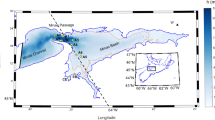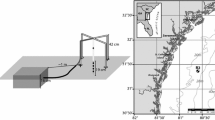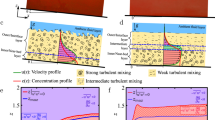Abstract
Sandy subtidal sediments are part of the earth's largest filter system. Water flow through bottom sediments is driven by wave action on the sea surface. The mechanisms involved are described, including a theoretical deduction and field measurements. As an example, the total water exchange through part of the West Atlantic shelf is computed and the influence of the phenomenon is discussed from a biological point of view and with regard to its importance for the world's oceans.
Similar content being viewed by others
Literature cited
Bigelow, H. and W. Edmondson: Wind waves at sea breakers and surf. Hydrogr. Bull., Wash. 602, 1–177 (1947).
Dietrich, G.: General oceanography, an introduction, 588 pp. New York: John Wiley & Sons 1957.
Eagleson, P. S. and W. van de Watering: A thermistor probe for measuring particle orbital speed in water waves. Tech. Memo. U.S. Army cstl Engng Res. Center, Washington Tech. Memo. U.S. Army cstl Engng Res. Center, Washington, D.C. 3, 1–44 (1964).
Fenchel, T. and R. J. Riedl: The sulfide system: a new biotic community underneath the oxidized layer of marine sand bottoms. Mar. Biol. 7, 255–268 (1970).
Hayes, M. O.: Relationship between coastal climate and bottom sediment type on the inner continental shelf. Mar. Geol. 5, 111–132 (1967).
Helle, J. R.: Surf statistics for the coasts of the United States. Tech. Memo. Beach Eros. Bd U.S. 108, 1–21 (1958).
Huang, N. E.: Mass transport induced by wave motion. J. mar. Res. 28, 35–50 (1970).
Hunt, J. N.: On the damping of gravity waves propagated over a permeable surface. J. geophys. Res. 64, 437–442 (1959).
Kossinna, E.: Die Tiefen des Weltmeeres. Veröff. Inst. Meeresk. Univ. Berl. 9, 1–70 (1921).
Lumley, J. L.: The constant temperature hot-thermistor anemometer; In: Symposium on Measurement in Unsteady Flow, pp 75–82. Worcester, Mass. 1962.
Menard, H. W. and S. M. Smith: Hypsometry of ocean basin provinces. J. geophys. Res. 71, 4305–4325 (1966).
Murray, J. D.: Viscous damping of gravity waves over a permeable bed. J. geophys. Res. 70, 2325–2331 (1965).
Neumann, G.: On ocean wave spectra and a new method of forecasting wind-generated sea. Tech. Memo. Beachs Eros. Bd U.S. 43, (1953).
Ott, J. and R. Machan: Dynamics of climatic parameters in intertidal sediments. Thalassia (In press).
Phillips, O. M.: The dynamics of upper ocean, 261 pp. Cambridge: University Press 1966.
Putnam, J. A.: Loss of wave energy due to percolation in a permeable sea bottom. Trans. Am. geophys. Un. 30, 349–356 (1949).
Reid, R. O. and K. Kajiura: On the damping of gravity waves over a permeable sea bed. Trans. Am. geophys. Un. 38, 662–666 (1957).
Reineck, H.-E.: Der Kastengreifer. Natur Mus., Frankf. 93, 102–108 (1963).
Riedl, R. J.: Gnathostomulida from America. Science, N.Y. 163, 445–452 (1969).
Riedl, R. J.: How much seawater passes through intertidal interstices? Int. Rev. ges. Hydrobiol. (1971). (In press).
— and R. Machan: Hydrodynamic patterns in lotic intertidal sands and their bioclimatological implications. Mar. Biol. 13, 179–209 (1972).
Riedl, R. J. and E. A. McMahan: High energy beaches. In: Coastal ecological systems of the United States, Ed. by H. T. Odum, B. J. Copeland and E. A. McMahan. 1969.
— and J. Ott: The suction corer, a device to yield electric potentials in coastal sediment layers. Senckenberg. marit. 2, 67–84 (1971).
Schlichting, H.: Boundary-layer theory, 747 pp. New York: McGraw-Hill 1968.
Shepard, F. P.: Submarine geology, 348 pp. New York: Harper and Brothers 1948.
Stoddart, D. R.: World erosion and sedimentation. In: Water, earth, and man, pp 43–64. Ed. by R. J. Chorley. London: Methuen Co. Ltd. 1969.
Sverdrup, H., M. Johnson and R. Fleming: The oceans and their physics, chemistry, and general biology, 1060 pp. Englewood Cliffs, N. J.: Prentice-Hall.
Webb, J. E. and J. Theodor: Irrigation of submerged marine sands through wave action. Nature, Lond. 220, 682–683 (1968).
Author information
Authors and Affiliations
Additional information
Communicated by O. Kinne, Hamburg
Rights and permissions
About this article
Cite this article
Riedl, R.J., Huang, N. & Machan, R. The subtidal pump: a mechanism of interstitial water exchange by wave action. Mar. Biol. 13, 210–221 (1972). https://doi.org/10.1007/BF00391379
Accepted:
Issue Date:
DOI: https://doi.org/10.1007/BF00391379




